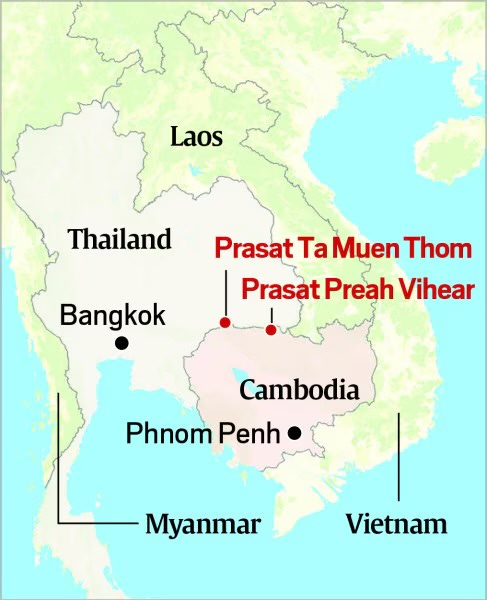The Cambodia-Thailand Border Conflict
The border conflict between Cambodia and Thailand, a simmering dispute with roots stretching back over a century, has flared into one of Southeast Asia’s most serious confrontations in recent years.
Centered on contested territories near ancient Khmer temples and fueled by nationalist fervor, the conflict has escalated since May 2025, resulting in military clashes, civilian casualties, and a sharp decline in diplomatic relations.
Historical Context: A Century-Old Dispute
The origins of the Cambodia-Thailand border conflict lie in the colonial era. In 1907, when Cambodia was under French rule, France and the Kingdom of Siam (now Thailand) signed a treaty to delineate their shared border. The accompanying map placed the Preah Vihear Temple, an 11th-century Khmer masterpiece in the Dângrêk Mountains, within Cambodian territory. However, inconsistencies between the map and the treaty text left room for interpretation, sowing the seeds of future disputes.
The issue came to a head after Cambodia gained independence in 1954. Thailand occupied the Preah Vihear Temple, prompting Cambodia to appeal to the International Court of Justice (ICJ) in 1959. In 1962, the ICJ ruled in Cambodia’s favor, affirming its sovereignty over the temple but leaving the status of the surrounding land unresolved. This ambiguity has triggered periodic tensions, including violent clashes in 2008 and 2011, as both nations claim overlapping territories based on historical and legal arguments.
Recent Escalation: From Skirmishes to Warfare
The latest escalation began in May 2025 with the death of a Cambodian soldier in a skirmish near the Emerald Triangle, a disputed region where Cambodia, Thailand, and Laos converge. Cambodia accused Thai forces of attacking one of its bases, while Thailand claimed its troops fired in self-defense after Cambodian provocation. The incident ignited a rapid escalation, with both nations deploying troops and heavy weaponry to the border.
By July 24, 2025, the situation had deteriorated into open conflict. Heavy fighting broke out, involving artillery, rocket fire, and airstrikes. Thailand reported 12 civilian deaths and one soldier killed, while Cambodia confirmed at least one civilian casualty. The violence displaced tens of thousands—over 131,000 Thais evacuated border areas, and hundreds of Cambodians fled their homes. Both sides accused the other of initiating the hostilities, with Thailand alleging Cambodian aggression and Cambodia claiming Thai forces violated prior agreements by advancing into disputed zones.
Cambodia’s Perspective: Defending Sovereignty and Heritage
Cambodia views the conflict as a defense of its territorial integrity and cultural heritage against Thai encroachment. The government asserts sovereignty over disputed areas, including the Preah Vihear Temple and Prasat Ta Muen Thom, citing the 1962 ICJ ruling and historical ties to the Khmer Empire. Cambodian officials have accused Thailand of breaching agreements and disrespecting its borders, framing the conflict as an existential struggle for national pride.
Nationalism drives Cambodia’s stance, amplified by former Prime Minister Hun Sen, now Senate President and a dominant political figure. Hun Sen has rallied domestic support by portraying the conflict as a stand against Thai aggression, a tactic that distracts from economic woes—such as a post-pandemic recovery and looming U.S. tariffs—and bolsters the ruling party’s legitimacy.
Cambodia’s military buildup, including heavy weapons, and its filing of a new ICJ case in June 2025 (despite Thailand’s rejection of the court’s jurisdiction) underscore its resolve. Diplomatically, Cambodia has downgraded ties with Thailand, expelling diplomats and recalling its ambassador, signaling a hardline approach.
Thailand’s Perspective: Securing Borders and National Interests
Thailand, conversely, sees the conflict as a necessary defense of its territorial claims and security. The government argues that the border remains incompletely demarcated, asserting rights to areas like the Emerald Triangle and temple vicinities based on its own historical interpretations. Thai officials have accused Cambodia of initiating the violence and targeting civilians with heavy weaponry, calling such actions “inhumane.”
Domestic politics heavily influence Thailand’s position. Prime Minister Paetongtarn Shinawatra, daughter of former leader Thaksin Shinawatra, faces pressure to adopt a firm stance after a leaked call with Hun Sen sparked public backlash for appearing conciliatory. The powerful Thai military has taken a leading role, controlling border checkpoints and launching airstrikes framed as self-defense. Thailand has also closed border crossings and threatened economic sanctions, aiming to pressure Cambodia while appeasing nationalist sentiment at home amid criticism of Paetongtarn’s leadership.
International Involvement: China and the U.S. Step In
The conflict has attracted global attention, particularly from China and the United States. China, with strong economic ties to both nations, has offered to mediate, urging “friendly dialogue” while maintaining neutrality. However, its closer relationship with Cambodia—through investments and military ties—raises suspicions in Thailand. The United States, allied with Thailand via a security treaty, has called for peace but wields less influence due to strained relations after imposing tariffs on both countries. China’s mediation role could enhance its regional clout, potentially shifting Southeast Asia’s power dynamics.
Potential Consequences: Economic and Regional Risks
The conflict threatens severe repercussions. Economically, Cambodia’s tourism and garment sectors and Thailand’s border provinces face disruption from closed crossings and trade halts, compounding existing challenges like U.S. tariffs. Regionally, the Association of Southeast Asian Nations (ASEAN) risks losing credibility if it fails to address the crisis, potentially destabilizing Southeast Asia further if escalation draws in other powers.
Seeking a Way Forward
The Cambodia-Thailand border conflict intertwines historical grievances, nationalist politics, and unresolved territorial claims. Cambodia defends its sovereignty and heritage, while Thailand protects its borders and security, each driven by domestic pressures. International mediation, possibly led by China, and adherence to past rulings like the ICJ’s could pave the way for peace. Yet, with both sides entrenched and the situation volatile, the coming weeks will determine whether this longstanding dispute escalates further or finds a peaceful resolution, sparing Southeast Asia from deeper instability.




